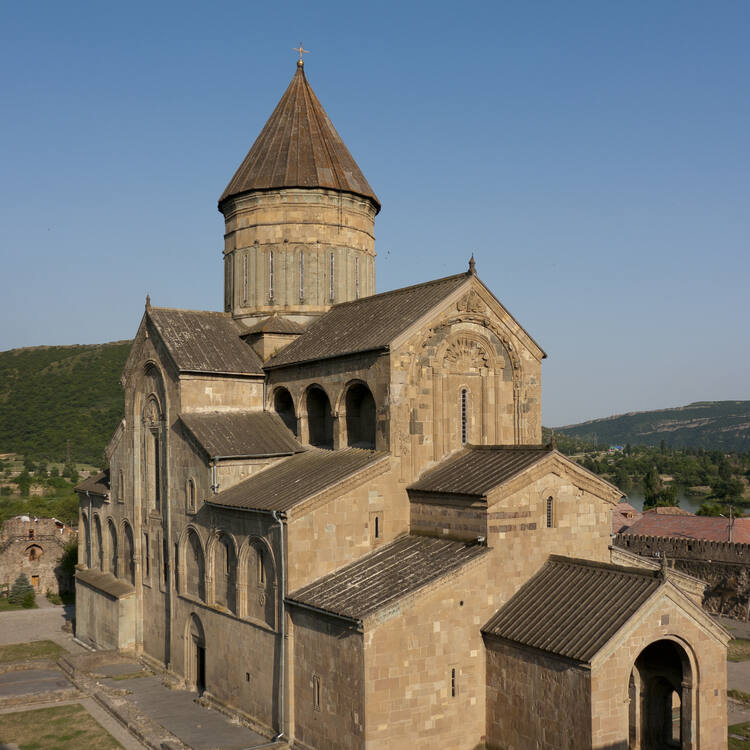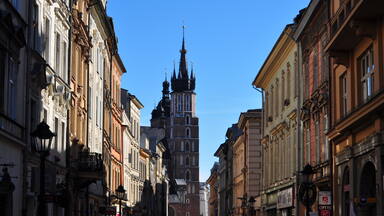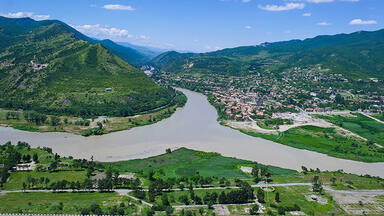Historical Monuments of Mtskheta
Historical Monuments of Mtskheta
The historic churches of Mtskheta, former capital of Georgia, are outstanding examples of medieval religious architecture in the Caucasus. They show the high artistic and cultural level attained by this ancient kingdom.
Description is available under license CC-BY-SA IGO 3.0
Monuments historiques de Mtskheta
Les églises historiques de Mtskheta, ancienne capitale du royaume de Géorgie, sont des exemples exceptionnels de l'architecture religieuse du Moyen Âge dans la région du Caucase. Elles témoignent du haut niveau artistique et culturel qu'avait atteint cet ancien royaume.
Description is available under license CC-BY-SA IGO 3.0
محمية المدينة-المتحف متسخيتا
تشكّل الكنائس التاريخية في متسخيتا، وهي العاصمة القديمة لمملكة جيورجيا، نماذج رائعة للهندسة الدينية في القرون الوسطى في منطقة القوقاز، كما تدلّ على المستوى الفني والثقافي الرفيع الذي بلغته هذه المملكة القديمة.
source: UNESCO/CPE
Description is available under license CC-BY-SA IGO 3.0
姆茨赫塔古城
格鲁吉亚前首都姆茨赫塔古城的教堂是高加索地区中世纪宗教建筑的杰出典范,展示了这个古代王国极高的艺术和文化水平。
source: UNESCO/CPE
Description is available under license CC-BY-SA IGO 3.0
Исторические памятники Мцхеты
Древние церкви Мцхеты, бывшей столицы Грузии, представляют собой выдающиеся образцы средневековой религиозной архитектуры Кавказа. Они ярко свидетельствуют о высоком художественном и культурном уровне, достигнутом этим государством. Важнейшие памятники Мцхеты – храм Джвари (конец VI - начало VII вв.), кафедральный собор Светицховели (начало XI в.) и монастырь Самтавро с купольным храмом XI в. и колокольней XV–XVII вв.
source: UNESCO/CPE
Description is available under license CC-BY-SA IGO 3.0
Monumentos históricos de Mtskheta
Las iglesias históricas de Mtskheta, capital del antiguo reino de Georgia, constituyen ejemplos excepcionales de la arquitectura religiosa medieval en la región del Cáucaso. Atestiguan el alto nivel alcanzado por las artes y la cultura en ese reino.
source: UNESCO/CPE
Description is available under license CC-BY-SA IGO 3.0
ムツヘタの文化財群
source: NFUAJ
Historische monumenten van Mtskheta
Source: unesco.nl
Outstanding Universal Value
Brief synthesis
The Historical Monuments of Mtskheta are located in the cultural landscape at the confluence of the Aragvi and Mtkvari Rivers, in Central-Eastern Georgia, some 20km northwest of Tbilisi in Mtskheta. The property consists of the Jvari Monastery, the Svetitstkhoveli Cathedral and the Samtavro Monastery.
Mtskheta was the ancient capital of Kartli, the East Georgian Kingdom from the 3rd century BC to the 5th century AD, and was also the location where Christianity was proclaimed as the official religion of Georgia in 337. To date, it still remains the headquarters of the Georgian Orthodox and Apostolic Church.
The favourable natural conditions, its strategic location at the intersection of trade routes, and its close relations with the Roman Empire, the Persian Empire, Syria, Palestine, and Byzantium, generated and stimulated the development of Mtskheta and led to the integration of different cultural influences with local cultural traditions. After the 6th century AD, when the capital was transferred to Tbilisi, Mtskheta continued to retain its leading role as one of the important cultural and spiritual centres of the country.
The Holy Cross Monastery of Jvari, Svetitskhoveli Cathedral and Samtavro Monastery are key monuments of medieval Georgia. The present churches include the remains of earlier buildings on the same sites, as well as the remains of ancient wall paintings. The complex of the Svetitskhoveli Cathedral in the centre of the town includes the cathedral church, the palace and the gates of the Katolikos Melchizedek that date from the 11th century, built on the site of earlier churches dating back to the 5th century. The cruciform cathedral is crowned with a high cupola over the crossing, and there are remains of important wall paintings in the interior. The rich sculpted decoration of the elevations dates from various periods over its long history. The small domed church of the Samtavro Monastery was originally built in the 4th century and has since been subject to various restorations. The main church of the monastery was built in the early 11th century. It contains the grave of Mirian III, the king of Iberia who established Christianity as official religion in Georgia.
The Historical Monuments of Mtskheta contain archaeological remains of great significance that testify to the high culture in the art of building, masonry crafts, pottery, as well as metal casting and processing, and the social, political, and economic evolution of this mountain kingdom for some four millennia. They also represent associative values with religious figures, such as Saint Nino, whose deeds are documented by Georgian, Armenian, Greek and Roman historians, and the 6th-century church in Jvari Monastery remains the most sacred place in Georgia.
Criterion (iii): The historical monuments of Mtskheta bear testimony to the high level of art and culture of the vanished Kingdom of Georgia, which played an outstanding role in the medieval history of its region. They express the introduction and diffusion of Christianity to the Caucasian mountain region and bear testimony of the social, political and economic evolution of the region since the late 3rd millennium BC.
Criterion (iv): The historic churches of Mtskheta, including Jvari Monastery, Svetitskhoveli Cathedral and Samtavro Monastery, are outstanding examples of medieval ecclesiastical architecture in the Caucasus region, and represent different phases of the development of this building typology, ranging from the 4th to the 18th centuries.
Integrity
The Historical Monuments of Mtskheta is a serial property that includes the Holy Cross Monastery of Jvari, Svetitskhoveli Cathedral and Samtavro Monastery, all attributes that represent the development of the building typology from the 4th to the 18th centuries. The components of the property have retained their material integrity and significant features conveying their Outstanding Universal Value. The impact of deterioration processes is controlled through ongoing conservation and maintenance programmes. The monuments form important landmarks within the cultural landscape of the Mtskheta river valley. The visual qualities of the setting are maintained through legal and administrative measures as part of the management regime. However, unifying the buffer zone remains a crucial measure to enhance the protection of the property and to allow a clear understanding of the archaeological and visually sensitive areas around the property. Potential threats to the setting of the property, derived from development projects, will also need to be controlled through appropriate land use planning.
Authenticity
There have been a number of reconstructions and restorations at the Jvari Monastery, Svetitskhoveli Cathedral and Samtavro Monastery. Many of the works carried out in the 19th century were typical for their time and do not conform to modern conservation standards. Notwithstanding, in terms of materials and techniques, the architectural ensemble retains a relatively high level of authenticity, while the authenticity of the setting and the archaeological sites is significantly high. In addition, Mtskheta has maintained its role as the spiritual and cultural centre of the country, assumed ever since the introduction of Christianity in the region.
Protection and management requirements
Based on the respective legal acts of the National Legislation of Georgia enforced in 1940 and 1957, Mtskheta and its surroundings were granted the status of Archaeological-Architectural Reserve in 1977. Mtskheta was defined as a town-museum and a plan for its development, which provided for the preservation of the scale and townscape, was approved in 1973. Since the 1990s, the protection of the property has been regulated on the basis of the national cultural heritage and spatial planning legislation.
The system of cultural heritage protection zones was enforced in 2006 and amended in 2012. A Management Plan has been prepared but there are still challenges in improving the site management mechanism and the coordination between the different management stakeholders. This would guarantee more coherent decision-making over the land use in the buffer zone of the property and prevent inappropriate interventions in the landscape setting of the property. The implementation of Urban Land-Use Master Plans, which include zoning regulations to establish no construction zones and limit development in relation to the attributes of the property and specific landscape setting, with associated important views and connection lines, will be crucial for sustaining the conditions of integrity.






